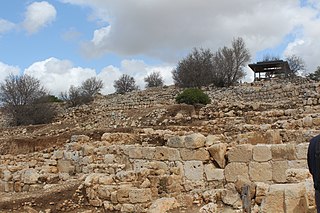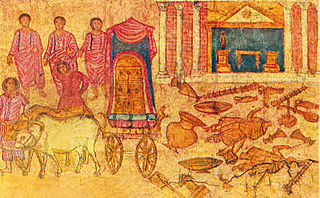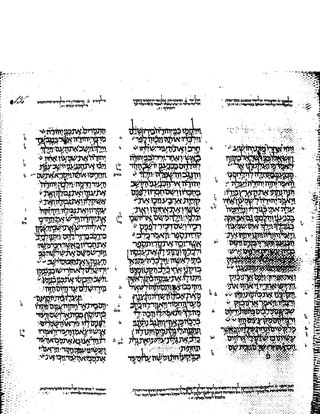Related Research Articles

The Ark of the Covenant, also known as the Ark of the Testimony or the Ark of God, is a purported religious storage and relic held to be the most sacred object by the Israelites.

The Book of Judges is the seventh book of the Hebrew Bible and the Christian Old Testament. In the narrative of the Hebrew Bible, it covers the time between the conquest described in the Book of Joshua and the establishment of a kingdom in the Books of Samuel, during which Biblical judges served as temporary leaders.

The Book of Samuel is a book in the Hebrew Bible, found as two books in the Old Testament. The book is part of the Deuteronomistic history, a series of books that constitute a theological history of the Israelites and that aim to explain God's law for Israel under the guidance of the prophets.
The Book of Exodus is the second book of the Bible. It is a narrative of the Exodus, the origin myth of the Israelites leaving slavery in Biblical Egypt through the strength of their deity named Yahweh, who according to the story chose them as his people. The Israelites then journey with the legendary prophet Moses to Mount Sinai, where Yahweh gives the Ten Commandments and they enter into a covenant with Yahweh, who promises to make them a "holy nation, and a kingdom of priests" on condition of their faithfulness. He gives them their laws and instructions to build the Tabernacle, the means by which he will come from heaven and dwell with them and lead them in a holy war to conquer Canaan, which has earlier, according to the myth of Genesis, been promised to the "seed" of Abraham, the legendary patriarch of the Israelites.

The Philistines were an ancient people who lived on the south coast of Canaan during the Iron Age in a confederation of city-states generally referred to as Philistia.

Saul was a monarch of ancient Israel and Judah and the first king of the United Monarchy, according to the Hebrew Bible and Old Testament. His reign, traditionally placed in the late eleventh century BCE, supposedly marked the transition of the Israelites from a scattered tribal society ruled by various judges to organized statehood.

Samuel is a figure who, in the narratives of the Hebrew Bible, plays a key role in the transition from the biblical judges to the United Kingdom of Israel under Saul, and again in the monarchy's transition from Saul to David. He is venerated as a prophet in Judaism, Christianity, and Islam. In addition to his role in the Bible, Samuel is mentioned in Jewish rabbinical literature, in the Christian New Testament, and in the second chapter of the Quran. He is also treated in the fifth through seventh books of Antiquities of the Jews, written by the Jewish scholar Josephus in the first century. He is first called "the Seer" in 1 Samuel 9:9.

Goliath is a Philistine warrior in the Book of Samuel. Descriptions of Goliath's immense stature vary among biblical sources, with the Masoretic Text describing him as 9 feet 9 inches (2.97 m) tall. According to the text, Goliath issued a challenge to the Israelites, daring them to send forth a champion to engage him in single combat; he was ultimately defeated by the young shepherd David, employing a sling and stone as a weapon. The narrative signified King Saul's unfitness to rule, as Saul himself should have fought for Israel.
Obed-Edom or Oved Edom is a biblical name which in Hebrew means "servant of Edom," and which appears in the books of 2 Samuel and 1 and 2 Chronicles. The relationship between these passages has been the subject of scholarly discussions which express uncertainty and disagreements about the relationships between various passages that use the name.

Shiloh was an ancient city and sanctuary in ancient Israel located in the region of Samaria. According to the Hebrew Bible, Shiloh was one of the main centers of Israelite worship during the pre-monarchic period, before the First Temple in Jerusalem was built. After the Israelite conquest of Canaan, the Tabernacle was moved to Shiloh, and remained there during the period of the biblical judges.
Ichabod is mentioned in the first Book of Samuel as the son of Phinehas, a priest at the biblical shrine of Shiloh, who was born on the day that the Israelites' Ark of God was taken into Philistine captivity. His mother went into labour due to the shock of hearing that her husband and Eli, her father-in-law, had died and that the Ark had been captured. He is also named later as the brother of Ahitub.
A guilt offering, also referred to as a trespass offering, was a type of Biblical sacrifice, specifically a sacrifice made as a compensation payment for unintentional and certain intentional transgressions. It was distinct from the Biblical sin offering.

The Philistine captivity of the Ark was an episode described in the biblical history of the Israelites, in which the Ark of the Covenant was in the possession of the Philistines, who had captured it after defeating the Israelites in a battle at a location between Eben-ezer, where the Israelites encamped, and Aphek, where the Philistines encamped.

The Battle of Aphek is a biblical episode described in the First Book of Samuel 4:1–10 of the Hebrew Bible. During this battle the Philistines defeated the Israelite army and captured the Ark of the Covenant. Among biblical scholars, the historicity of the early events in the Books of Samuel is debated, with some scholars leaning toward many events in Samuel being historical, and some scholars leaning towards less.

1 Samuel 5 is the fifth chapter of the First Book of Samuel in the Old Testament of the Christian Bible or the first part of the Books of Samuel in the Hebrew Bible. According to Jewish tradition the book was attributed to the prophet Samuel, with additions by the prophets Gad and Nathan, but modern scholars view it as a composition of a number of independent texts of various ages from c. 630–540 BCE. This chapter describes how the Ark of Covenant was taken by the Philistines, a part of the "Ark Narrative" within a section concerning the life of Samuel.

1 Samuel 4 is the fourth chapter of the First Book of Samuel in the Old Testament of the Christian Bible or the first part of the Books of Samuel in the Hebrew Bible. According to Jewish tradition the book was attributed to the prophet Samuel, with additions by the prophets Gad and Nathan, but modern scholars view it as a composition of a number of independent texts of various ages from c. 630–540 BCE. This chapter describes how the Ark of Covenant was taken by the Philistines, a part of the "Ark Narrative" within a section concerning the life of Samuel.

1 Samuel 6 is the sixth chapter of the First Book of Samuel in the Old Testament of the Christian Bible or the first part of the Books of Samuel in the Hebrew Bible. According to Jewish tradition the book was attributed to the prophet Samuel, with additions by the prophets Gad and Nathan, but modern scholars view it as a composition of a number of independent texts of various ages from c. 630–540 BCE. This chapter describes how the Ark of Covenant was returned to Israel by the Philistines, a part of the "Ark Narrative" within a section concerning the life of Samuel.

1 Samuel 7 is the seventh chapter of the First Book of Samuel in the Old Testament of the Christian Bible or the first part of the Books of Samuel in the Hebrew Bible. According to Jewish tradition the book was attributed to the prophet Samuel, with additions by the prophets Gad and Nathan, but modern scholars view it as a composition of a number of independent texts of various ages from c. 630–540 BCE. This chapter records a victory of Israel under the leadership of Samuel against the Philistines as part of the "Ark Narrative" within a section concerning the life of Samuel, and also as part of a section comprising 1 Samuel 7–15 which records the rise of the monarchy in Israel and the account of the first years of King Saul.

Judges 13 is the thirteenth chapter of the Book of Judges in the Old Testament or the Hebrew Bible. According to Jewish tradition the book was attributed to the prophet Samuel, but modern scholars view it as part of the Deuteronomistic History, which spans in the books of Deuteronomy to 2 Kings, attributed to nationalistic and devotedly Yahwistic writers during the time of the reformer Judean king Josiah in 7th century BCE. This chapter records the activities of judges Samson. belonging to a section comprising Judges 13 to 16 and Judges 6:1 to 16:31.
War in the Hebrew Bible concerns any military engagement narrated or discussed in the Hebrew Bible, also known as the Tanakh or Old Testament of the Bible. Texts about war in the Hebrew Bible are part of the broader topic of The Bible and violence. They cover a wide range of topics from detailed battle reports including weapons and tactics used, numbers of combatants involved, and casualties experienced, to discussions of motives and justifications for war, the sacred and secular aspects of war, descriptions and considerations of what in the modern era would be considered war crimes, such as genocide or wartime sexual violence, and reflections on wars that have happened, or predictions, visions or imaginations of wars that are yet to come.
References
- ↑ Fowler FG (1919). The Concise Oxford Dictionary of Current English (7th ed.).
- ↑ 1 Sam 5:6
- ↑ 1 Sam 6:4
- ↑ Forder R (1890). "A Bible Disease". Freethinker. 10: 39.
- ↑ Alex. Macalister. "Emerods". International Standard Bible Encyclopedia Online. Retrieved 8 February 2016.
- ↑ Conrad LI (1984). "The biblical tradition for the plague of the Philistines". Journal of the American Oriental Society. 104 (2): 281–7. doi:10.2307/602172. JSTOR 602172.
- ↑ Khan IA (2004). "Plague: the dreadful visitation occupying the human mind for centuries". Trans. R. Soc. Trop. Med. Hyg. 98 (5): 270–7. doi:10.1016/S0035-9203(03)00059-2. PMID 15109549.
- ↑ King DF (1985). "The biblical plague of 'hemorrhoids' An outbreak of bilharziasis". The American Journal of Dermatopathology. 7 (4): 341–6. doi:10.1097/00000372-198508000-00005. PMID 3939579.
- ↑ Punzo F (2012). The Biology of Camel-Spiders: Arachnida, Solifugae. Springer Science & Business Media. p. 3. ISBN 9781461557272.